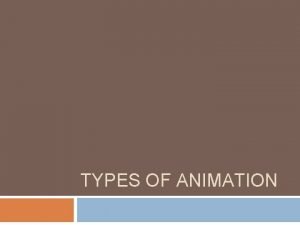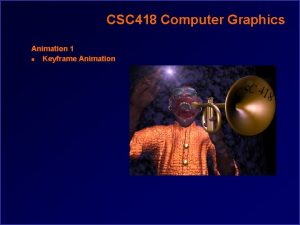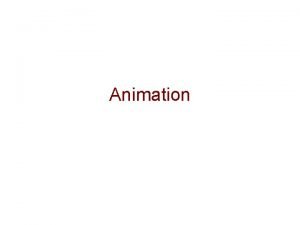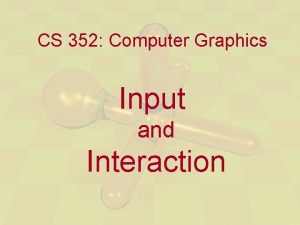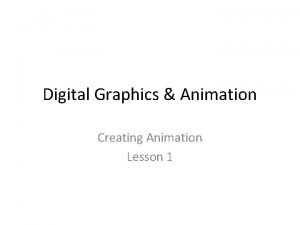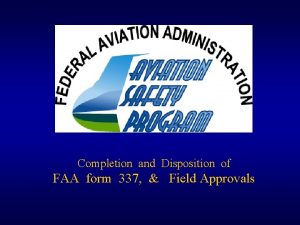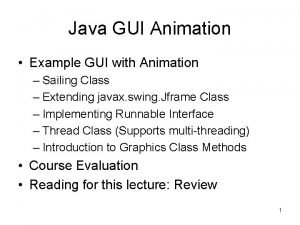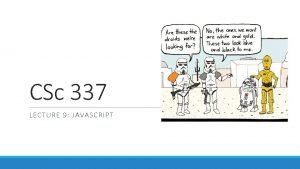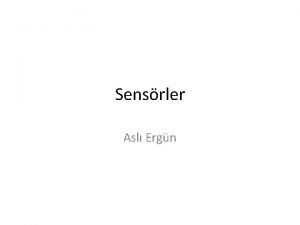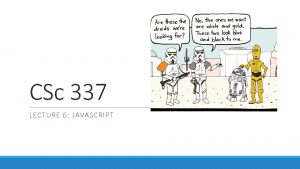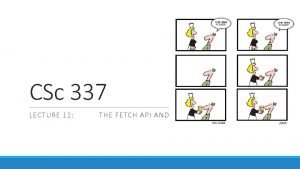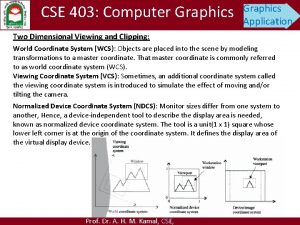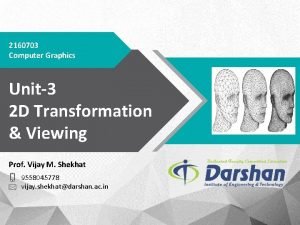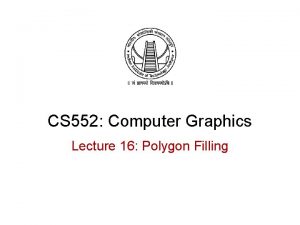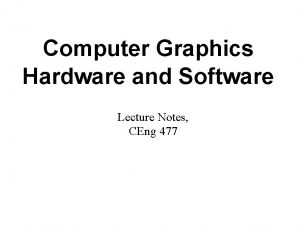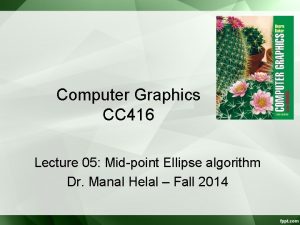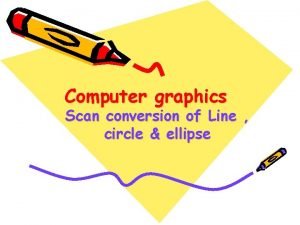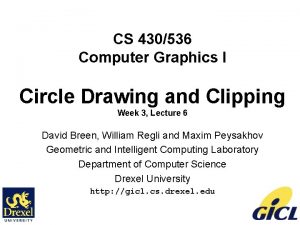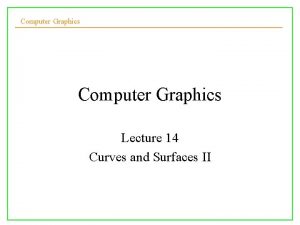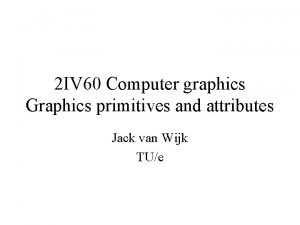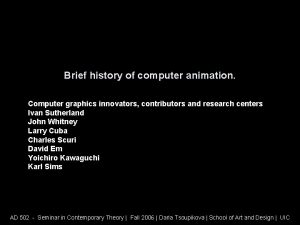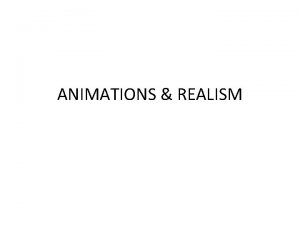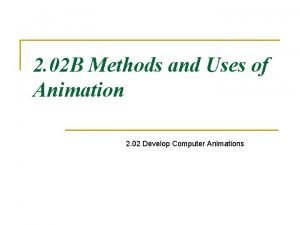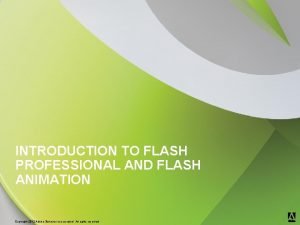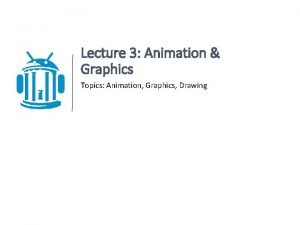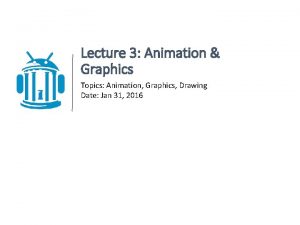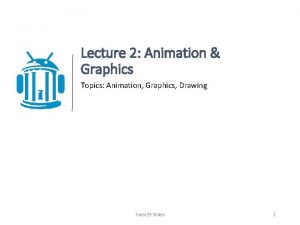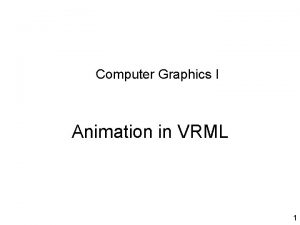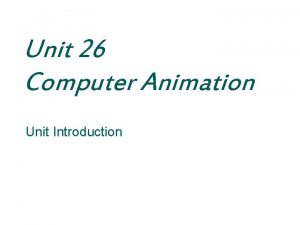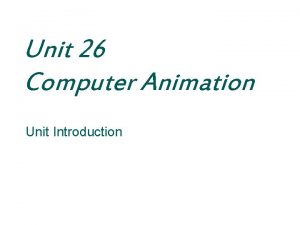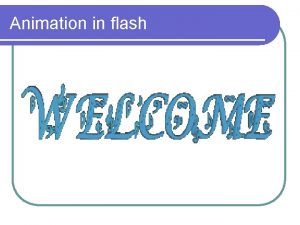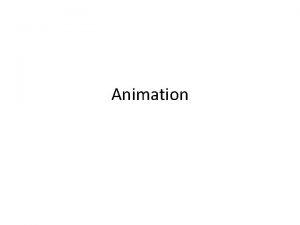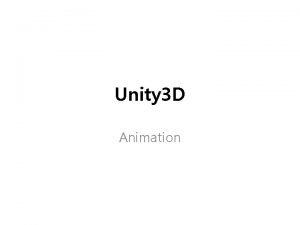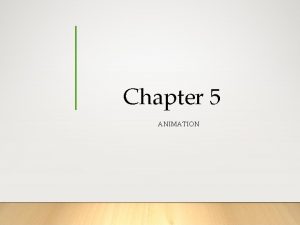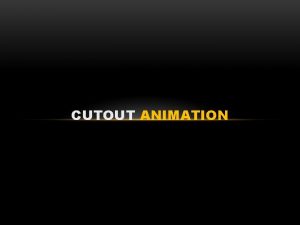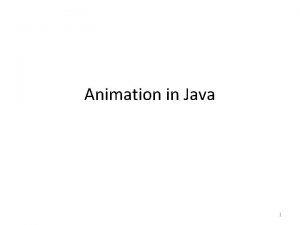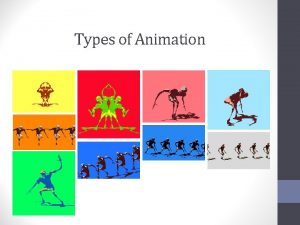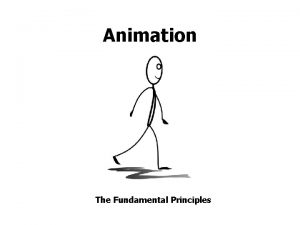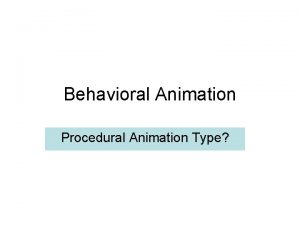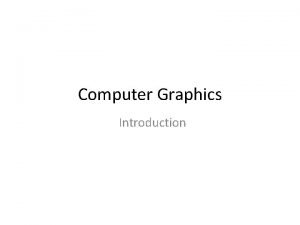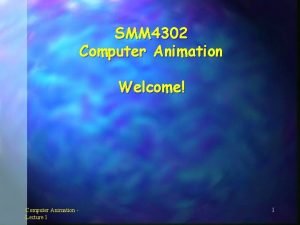COM 337 Computer Graphics Animation and Interaction Introduction






































- Slides: 38

COM 337 Computer Graphics Animation and Interaction

Introduction • Our examples until now were all static – We described a scene, sent data to GPU and rendered • Most real applications require user interaction and dynamically changing output • Now, we will look at – creating animation, and – user interaction

Animation • We want to display a square that rotates • One option is to – generate new vertex data after each rotation, – send these to the GPU each time, and – redraw • This is not very efficient because we send data from CPU to GPU for each frame • Instead, we will have a recursive render function

The Rotating Square •

The Rotating Square •

The Rotating Square •

Vertex Shader attribute vec 4 v. Position; uniform float theta; void main() { gl_Position. x = -sin(theta) * v. Position. x + cos(theta) * v. Position. y; gl_Position. y = sin(theta) * v. Position. y + cos(theta) * v. Position. x; gl_Position. z = 0. 0; gl_Position. w = 1. 0; }

The Rotating Square •

New Render Function function render() { gl. clear(gl. COLOR_BUFFER_BIT); theta += 0. 1; gl. uniform 1 f(theta. Loc, theta); gl. draw. Arrays(gl. TRIANGLE_STRIP, 0, 4); render(); }

The Rotating Square • The render function recursively calls itself infinitely and changes theta but we won’t see that change on screen • Single Buffer vs. Double Buffer – If there is a single color buffer, we will be both displaying it and changing it • This may cause undesired displays – Because of this, we use double buffering • 2 color buffers (front and back) • Front buffer is displayed while changes are made to the back buffer • When we finish changes and want to update display, we swap buffers

Buffer Swap • We can swap buffers – Using timers, or – Using request. Anim. Frame function • Timers allow us to call the render function repeatedly with a specific interval in milliseconds set. Interval(render, 16) • 0 ms as a parameter cause it to be executed as fast as possible

Buffer Swap • request. Anim. Frame function render() { gl. clear(gl. COLOR_BUFFER_BIT); theta += 0. 1; gl. uniform 1 f(theta. Loc, theta); gl. draw. Arrays(gl. TRIANGLE_STRIP, 0, 4); request. Anim. Frame(render); }

Buffer Swap function render() { set. Timeout(function() { request. Anim. Frame(render); gl. clear(gl. COLOR_BUFFER_BIT); theta += 0. 1; gl. uniform 1 f(theta. Loc, theta); gl. draw. Arrays(gl. TRIANGLE_STRIP, 0, 4); }, 100); }

Interaction • Open. GL and Web. GL do not support interaction directly for portability reasons – For Open. GL to work in different environments, window and input functions are not included in the API • For desktop Open. GL, you need to use extra libraries such as GLUT (inter-platform), GLW (windows), GLX (x server), … • For Web. GL, we will make use of the facilities of HTML, browser, and Javascript.

Input Devices • We can think about input devices in 2 different ways: – As physical devices, or – As logical devices (what they do from the program’s perspective, i. e. , their interface with the program) • Consider the following int x; cin >> x; cout << x; • We expect x to get its value from keyboard and then it is displayed on screen • But, we could arrange it to receive its value from another program and/or write the output to a file. • Even when we use the keyboard and screen, using cin and cout doesn’t require us to know anything about their physical properties

Input Devices • When we output a string of characters using printf in C or cout in C++, the physical output device can be a terminal screen, a printer, or a disk file • So, functions like these actually represent a logical view of the output (or the input) • For graphical input devices such as a mouse, there are more options. For example, you can use it to – select a screen location, or – choose a menu item. • These will correspond to different logical functions (one gives an (x, y) coordinate pair to the program, but the other gives the identifier of the chosen menu item) • With the separation of physical and logical view, we can also replace a device without any modification to the program. – E. g. , same program can work with a mouse, a touch screen, or a trackball.

Physical Input Devices • Pointing devices and keyboard devices • Keyboards = codes: ASCII, Unicode, … • Mouse and trackball • Data tablets, touch pads, and touch screens • Joysticks • Multidimensional input devices

Logical Devices • Measure of a device – Character(s) pressed on keyboard – Position of cursor • Trigger of a device – Enter key – Mouse buttons • Application program can get the measure of a device – In request mode – In sample mode – In event mode

Input Modes • Request mode – Measure not returned until device is triggered (E. g. scanf or cin) – Program waits for (requests) input – User types or brings the cursor to a location in as much time as (s)he wants – With a certain trigger (Enter key, left click), measure (characters, location) is received by the program

Input Modes • Sample mode – Immediate – As soon as the program reaches the function, measure is returned – E. g. , to check the current location of the cursor • In both request and sample modes, inputs other than the one specified are ignored • With both of them, the program guides the user • They are not very useful if we want the user to control the flow of the program

Input Modes • Event mode – Each time a device is triggered, an event is generated – The measure, together with the device identifier is placed in an event queue – The application program can independently observe this queue and take action on or discard the next event – Or, the application can associate a callback function with a certain type of event • Mouse events (moving the mouse and pressing or releasing buttons) • Window events (opening, closing, resizing, minimizing) • Keyboard events (pressing or releasing keys) • OS or browser events (idle, load)

Programming Event-Driven Input • We will develop examples using callback functions • We will see various events recognized by Web. GL through HTML 5 • Web. GL does not include anything for input, so we use Javascript and HTML for the interaction • An event has a type (e. g. , click) and a target (a specific button, mouse) • Each event has a name that is recognized by Javascript (these names also appear as functions that start with on-, such as onload and onclick)

Programming Event-Driven Input • In our examples, we used a load event callback window. onload = function init() { … } • The callback functions that we associate with events are also called event listeners or event handlers

Adding a Button • Let’s change the direction of rotation for the rotating square program with a button • First, add a button to the web page with the following HTML code <button id = "Direction. Button"> Change Rotation Direction </button> • In the script, we introduce a variable to represent the current direction of rotation var direction = true; • And we update theta according to this value theta += (direction ? 0. 1 : -0. 1);

Adding a Button • Finally, we need to connect with the button and add an event listener with var my. Button = document. get. Element. By. Id("Direction. Button"); my. Button. add. Event. Listener("click", function() {direction = !direction; }); • or alternatively with document. get. Element. By. Id("Direction. Button"). onclick = function() { direction = !direction; }; • or with “mousedown” instead of “click” in either case

Adding a Button • Clicking any button will work with the previous program because we didn’t specify a button • If we only want left click, we can write my. Button. add. Event. Listener("click", function() { if (event. button == 0) { direction = !direction; } }); • For a 3 button mouse, 0 is left, 1 is middle, and 2 is right button.

Menus • Menus are specified by select elements in HTML • Each menu entry has text and an associated number (that we will use in the application) <select id="mymenu" size="3"> <option value="0"> Toggle Rotation Direction X </option> <option value="1">Spin Faster</option> <option value="2">Spin Slower</option> </select>

Menus • Again, we connect with the menu as an HTML element and write our callback function var m = document. get. Element. By. Id("mymenu"); m. add. Event. Listener("click", function() { switch (m. selected. Index) { case 0: direction = !direction; break; case 1: delay /= 2. 0; break; case 2: delay *= 2. 0; break; } });

Using Keycodes window. add. Event. Listener("keydown”, function() { switch (event. key. Code) { case 49: // ’ 1’ key direction = !direction; break; case 50: // ’ 2’ key delay /= 2. 0; break; case 51: // ’ 3’ key delay *= 2. 0; break; } }); window. onkeydown = function(event) { var key = String. from. Char. Code(event. key. Code); switch (key) { case ’ 1’: direction = !direction; break; case ’ 2’: delay /= 2. 0; break; case ’ 3’: delay *= 2. 0; break; } };

Sliders • A slider element is a useful GUI element • To create a slider in HTML to set the delay between 0 and 100 ms <div> speed 0 <input id="slide" type="range" min="0" max="100" step="10" value="50" /> 100 </div> • To get the value of the slider in the script document. get. Element. By. Id("slide"). onchange = function() {delay = this. value; };

Position Input •

Position Input canvas. add. Event. Listener("click", function(event) { gl. bind. Buffer(gl. ARRAY_BUFFER, v. Buffer); var t = vec 2(-1 + 2*event. client. X/canvas. width, -1 + 2*(canvas. height-event. client. Y) / canvas. height); gl. buffer. Sub. Data(gl. ARRAY_BUFFER, sizeof[’vec 2’]*index, t); index++; }); • What does the above code do?

Window Events • Resizing, minimizing, restoring, etc. are examples of window events • If window is resized, program can decide what to do • 3 questions in this case: – Do we draw all objects that were on the canvas before resizing? – What if aspect ratio has changed? – Do we change the size or attributes of new primitives?

Window Events • There is no single correct answer to these questions • We generally answer depending on the application and how we want the output to be after resizing • Suppose we want to display same contents as before and maintain proportions • Resizing happens for the entire browser window • The event returns the new window width and height (inner. Height and inner. Width)

Window Events • Original canvas width and height were canvas. width and canvas. height • As long as new window size is still larger than canvas size, we do not need to modify • Otherwise, we change the viewport to be small enough while maintaining proportions

Maintaining a square canvas window. onresize = function() { var min = inner. Width; if (inner. Height < min) { min = inner. Height; } if (min < canvas. width || min < canvas. height) { gl. viewport(0, canvas. height-min, min); } };

Selecting a Primitive • How can we do it?

Selecting a Primitive • How can we do it? – Geometry • Intersection calculation • (Axis-aligned) bounding boxes, or extents – Trick with drawing on an extra color buffer • gl. read. Pixels function
 Dậy thổi cơm mua thịt cá
Dậy thổi cơm mua thịt cá Cơm
Cơm Traditional animation vs computer animation
Traditional animation vs computer animation Hand held computer
Hand held computer Keyframe animation in computer graphics
Keyframe animation in computer graphics Animation meaning in computer
Animation meaning in computer Interaction in computer graphics
Interaction in computer graphics 3d viewing devices in computer graphics ppt
3d viewing devices in computer graphics ppt Digital graphics and animation
Digital graphics and animation Computer graphics ppt
Computer graphics ppt 337 form faa
337 form faa Java animation example
Java animation example 337 form example
337 form example 337 form example
337 form example 337info
337info Esneyebilen bir tabaka üzerine ince bir telin
Esneyebilen bir tabaka üzerine ince bir telin Csc 337
Csc 337 Csc 337
Csc 337 Exterior clipping
Exterior clipping Line in computer graphics
Line in computer graphics Normalized device coordinate
Normalized device coordinate Shear transformation in computer graphics
Shear transformation in computer graphics Mathematical foundations of computer graphics and vision
Mathematical foundations of computer graphics and vision Computer graphics chapter 1 ppt
Computer graphics chapter 1 ppt 8 connected boundary fill algorithm
8 connected boundary fill algorithm Hardware and software in computer graphics
Hardware and software in computer graphics Midpoint ellipse drawing algorithm example
Midpoint ellipse drawing algorithm example What is the basis of scan conversion of circle
What is the basis of scan conversion of circle Valuator devices in computer graphics
Valuator devices in computer graphics In random scan display, the frame buffer holds ….
In random scan display, the frame buffer holds …. Circle and ellipse drawing algorithm in computer graphics
Circle and ellipse drawing algorithm in computer graphics Computer graphics
Computer graphics Aliasing and antialiasing in computer graphics
Aliasing and antialiasing in computer graphics Convex and concave polygon in computer graphics
Convex and concave polygon in computer graphics Computer
Computer Direct motion specification
Direct motion specification What is path based animation
What is path based animation Introduction to flash
Introduction to flash Stanford human computer interaction
Stanford human computer interaction


